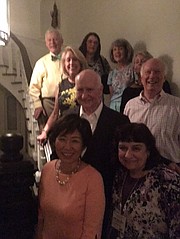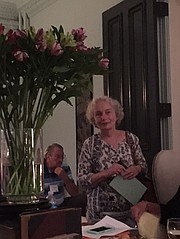The elegant Federal style mansion on the corner of Prince and S. Columbus streets has also been called stylistically “Italianate,” “Second Empire,” “Greek Revival” and “almost Spanish Baroque.” Architecturally speaking it is all these things. But the nurses who streamed through the ornate double-entrance doors of Swann-Daingerfield House Friday evening, Sept. 9, simply called it “home.”
Turns out the Alexandria Hospital School of Nursing (AHSN) — the school itself opened in 1894 — was located at Swann-Daingerfield from 1943 to 1973. Right next door was Alexandria Hospital, where the red brick Atrium building now stands.
The original 1802 mansion, built by prominent Alexandria lawyer Thomas Swann, was enlarged by succeeding owner and shipping magnate Henry Daingerfield. The entire structure was returned to use as a private residence from AHSN. In 1971 the city bought it and later turned it over to developers who converted the more than 50 bedrooms and classrooms used by students into 11 condominium apartments offered for sale in 1977. Swann’s original mansion with its 12’ 8” ceilings and first floor ballroom, where Lafayette was rumored to have danced, was left intact.
It was in this architectural gem of a building that the AHSN, class of ’76, held its 40th reunion. Penny and Jim Haybyrne, owners of the now-three story, restored original mansion, graciously offered their home for a kickoff cocktail-party reception, followed by house tours of four of the other homes. Sitting on his perch on the porch one day, Jim Haybyrne had been alerted to the upcoming weekend reunion by former student nurse, Linda Freschi Weyrich, ’74, now living only a block away on S. Alfred Street.
On learning some graduates had never had a reunion of their classes, the ’76 reunion organizers Gwen Poore Miller and Bobbi Kempter Pasternak, decided to open it up to all AHSN graduates. With no formal alumnae association they expected low turnout. But 58 of the women in white signed up.
Although the nursing school did not close until 1987, the class of ’76 was the last to have lived in Swann-Daingerfield and that for only one year. The building was then named “Carter Hall” in honor of Miss Fanny Carter, superintendent of nursing and director of AHSN for more than 20 years. They were also the last class to wear starched white cotton uniforms and do clinical rotations in the old Duke Street facility.
From the moment they began swanning through the doors at 6, the nurses were off and running. Classes represented ranged from ’71 to ’78. They had traveled from as far away as California, Seattle and Texas. The nurses snapped pictures of themselves on the Haybyrnes’ handsome grand staircase, which they had once been forbidden to use until after “capping” ceremony at the end of freshman year.
Indeed, the current owners learned more interesting things firsthand from the students about their individual homes than they could ever have imagined. Diane Dippold MacIntosh discovered her master bedroom had once slept three nurses, two in military style bunks and one in a proper single bed. The eldest of them (probably 20 years old instead of 19) rated the prized bed. This apartment is now the only one with an enclosed balcony, but back then the “sunroom” was open so the nurses sunbathed there. “It was our refuge,” said Connie Butler Ludtke, ’73. “And you could see across to the doctors with their binoculars,” another piped up.
Marsha and Bernard Murphy and Mary-Welby and Bill Garrison learned the nurses remembered seeing the Appomattox Confederate soldier from their upper-floor dorms as well as appreciated the building’s unique sky-high oval windows. Claire Burns learned her S. Columbus Street wing had once housed a chapel. Her wing had earlier been added by Holy Cross nuns who ran the all-girls St. Mary’s Academy (now on Russell Road) and who sold the building to Alexandria Hospital in 1942.
The nurses also shared personal stories with the owners, rattling off the school’s various thou-shalt-not’s. Carol Eldridge Cabrera, ’71, recalled: “We were not allowed to stand up and smoke. We were also taught how to roll the ash off a cigarette, not to tap it. Our uniforms had to be half-calf. We had to fold our apron over our lap so it didn’t get wrinkled when we sat down.”
The evening ended with the singing of school songs, from the slightly naughty “Carter Hall Song”:
Oh, I’m from Carter Hall so pity me.
Not a boy in the vicinity.
to the deeply religious “Bless These Caps”:
Bless these caps so pure and white,
Sat like halos beaming bright
Bless the hands that place them there
Hands well versed in others’ care.
Bless these candles shining bright
Symbols of thy heavenly light.
As darkness fell the main difference between 1976 and 2016 was the nurses’ candles were replaced by flashlights flickering from cell phones onto the song sheets. The beautiful bones of this house are a testament to its many seamless transitions from old to new. And for one shining night in September, thanks to a lot of people, Swann-Daingerfield was not only still alive and kicking but alive and singing.



